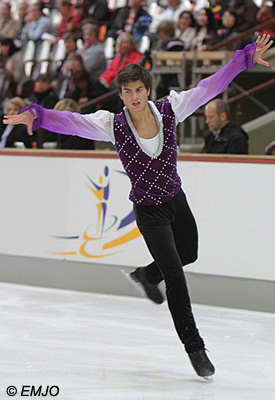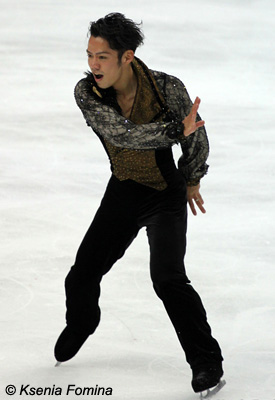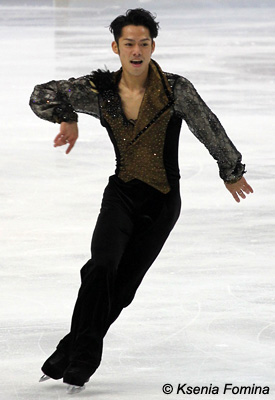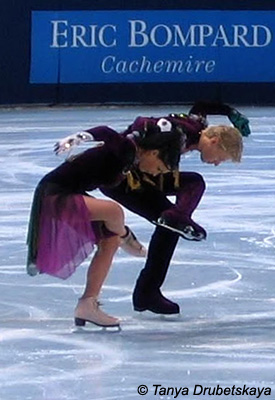Pasquale Camerlengo: "I don't like normal programs"
 November 13, 2011
By Reut Golinsky
Photo © Eva Maria Jangbro, Ksenia Fomina, Jennifer Comeaux, Tanya Drubetskaya, Reut Golinsky
 It was at the end of the Nebelhorn Trophy. The free dance had finished with a surprising victory for Americans Madison Hubbell and Zach Donohue, who teamed up only a few months earlier. Their coach, Pasquale Camerlengo, was standing near the kiss-and-cry receiving congratulations from his colleagues. Many skaters were approaching him too. "Ah, right," - I told myself. "He made the choreography for them this summer. And for them. And for him too. And for those skaters approaching him right now..."
His name has become more and more dominant with each season, certainly in ice dance, where he coaches a few top couples right now together with his two-time World champion wife, Angelika Krylova. But Pasquale's work as a choreographer is seen among pairs' and singles' as well. We talked about his students, his choreographies, the "ideal skater" and more.
It was at the end of the Nebelhorn Trophy. The free dance had finished with a surprising victory for Americans Madison Hubbell and Zach Donohue, who teamed up only a few months earlier. Their coach, Pasquale Camerlengo, was standing near the kiss-and-cry receiving congratulations from his colleagues. Many skaters were approaching him too. "Ah, right," - I told myself. "He made the choreography for them this summer. And for them. And for him too. And for those skaters approaching him right now..."
His name has become more and more dominant with each season, certainly in ice dance, where he coaches a few top couples right now together with his two-time World champion wife, Angelika Krylova. But Pasquale's work as a choreographer is seen among pairs' and singles' as well. We talked about his students, his choreographies, the "ideal skater" and more.
During the press conference, your students, Madison and Zach, were asked about the secret of their victory here. But the one to ask is probably you!
I think we did a good job. And when I say "we", I mean all of us, as I really believe in team work. Madison and Zach are talented skaters, they matched right away from the first day they started skating together. And of course we worked very hard with them, because we believe that they are a very good team and can be among the top couples.
Actually I planned to start our talk from congratulations for your another couple, Kaitlyn Weaver and Andrew Poje, who placed fifth at last Worlds. Was this result unexpected for you?
 Well, we were really pushing them towards this. When they came to us they were already good skaters, but they didn't believe that they could be among the best in the world. Back then we didn't have commitments to other top teams, so we invested a lot of time and energy into Weaver/Poje, to make them grow and believe that they are top skaters. It is unfortunate that they have never been Canada's first team (National champions). When you're introduced as the National champions, others view you differently. But their skills and their capability to skate made the difference at Worlds.
Well, we were really pushing them towards this. When they came to us they were already good skaters, but they didn't believe that they could be among the best in the world. Back then we didn't have commitments to other top teams, so we invested a lot of time and energy into Weaver/Poje, to make them grow and believe that they are top skaters. It is unfortunate that they have never been Canada's first team (National champions). When you're introduced as the National champions, others view you differently. But their skills and their capability to skate made the difference at Worlds.
To me their short dance was one of the most beautiful programs of the previous season.
Thank you. I think it matched their personalities. We tried to create something similar in style to Audrey Hepburn in "Breakfast at Tiffany's".
This year we have a Latin short dance. For the rhumba we chose a very well-known piece: "Historia de un amor". It is very sensual; there are beautiful accents in the music that we could find interesting movements to. And the samba part is very lively, enjoyable and entertaining.
For the free dance we tried to create something very emotional, based on the popular French song "Je suis malade". We use about 2 minutes 15 seconds of the original song with Lara Fabian, and the rest was composed just for this program, based on parts of the original music. We thought it'd be a good idea to use a French song as Weaver/ Poje have some competitions in Francophone areas: Worlds in Nice, the Grand Prix final in Quebec City. Nationals will be in a city with an active French-speaking population (Moncton, where one third of the population is French-speaking - ed.) So we said: "Why not? Our public will understand this song".
Did you set any goals for them this season, like being in the top 5 again, or higher?
I basically always ask them to do their best. I tell all my skaters: "Guys, you have to always fight as if you're going to win the competition even if you know there is no chance. But fight and show your best, and then when you sit in the kiss-and-cry, you will see what happens. Sometimes there are nice surprises, sometimes not. But everything depends on you, and you can finish the competition on a high note even when losing, because you achieved something".
 Let's move on to Nathalie Péchalat and Fabian Bourzat, who joined you this past summer. It must be harder for you to work with them than with your other teams as these two have been together a long time. They already have habits, their way of doing things.
Let's move on to Nathalie Péchalat and Fabian Bourzat, who joined you this past summer. It must be harder for you to work with them than with your other teams as these two have been together a long time. They already have habits, their way of doing things.
Yes, you raise a good point. I actually don't believe that people who reach a certain age can't improve. But sometimes it's stuck in the head of the skater, he says: "You know, I'm 30 years old, there is nothing else I can learn". But that's totally wrong. This happened in my career: as a skater I probably learned more when I was 28 years old than when I was 18. Maturity comes with age, which is important in ice dancing. It's important to look like you know what you're doing and that you're confident in it. To change coaches is hard, because everyone has a different approach. You have to be very careful not to make sudden changes from black to white, but first move to dark grey, then to grey, light grey and only then to white. So little by little I'm trying to make them understand that they can change; they can improve and they can find new things that they never tried before.
For example?
For example: they recently skated programs which were more interpretative, like "Zhivago", "Chaplin" and "Circus", where they were acting more than showing a real dance. In this year's free dance we went to another concept, with more focus on unity. To create the needed visual effect, they have to move in exactly the same way. This is something they were maybe less used to. They were more careful about the way they express feelings, and now they need to have the precision.  And they need the technique of the compulsory elements, to make the key point look cleaner. Sometimes they say: "Oh, we cannot do that. We are doing it our way because that's the way we learned it". But I say: "No, listen, we are going to try that and then you will tell me what you think about it". So they try once, twice and then they say: "Oh, maybe we can, maybe..." In the end they realize that their limit is not there, they haven't reached it yet; they can learn and improve more than they believed.
And they need the technique of the compulsory elements, to make the key point look cleaner. Sometimes they say: "Oh, we cannot do that. We are doing it our way because that's the way we learned it". But I say: "No, listen, we are going to try that and then you will tell me what you think about it". So they try once, twice and then they say: "Oh, maybe we can, maybe..." In the end they realize that their limit is not there, they haven't reached it yet; they can learn and improve more than they believed.
Who choreographed their programs for this season?
It was done in collaboration with different people. Nathalie and Fabian are used to working this way, and we want them to. Of course I'm also a choreographer, but I feel that there are people who are more specialized in certain things than I am. They went to France for the free dance, they worked with a choreographer who gave them some arm movements, some interesting movements in hip hop style and some transitions between elements. Angelika and I took it to the ice and created all the steps. Although the theme of their dance is Egyptian, the dance itself and the music are modern. It starts with Middle Eastern melodies from the soundtrack "The last temptation of Christ", and then it grows into almost techno music.
For the short dance we took them to a Latin dance studio to learn the basics of Latin dances. No choreography was created there, but they learned the attitude of how to perform certain moves. The actual choreography was made by Angelika and me.
You choreograph a lot, and not only for your own students or ice dancers. I tried to count how many of your programs we've seen during this competition alone. Michal Brezina - two programs, the German pair Hausch/Wende - both programs...
The Spanish dance team (Hurtado/Diaz) - both programs, Franz Streubel, Romain Ponsart...


Do you remember the very first program you choreographed?
The very first? Oh my goodness... When I was skating, back in the early 90ies, I always used to choreograph parts of my programs. Even if I was working with another choreographer who gave me some input, I used to do more than half of the program myself. I can't really say what my first choreography was, but probably in 93. I retired then and Carlo Fassi, who was working in Milan and who knew that I had quit skating, called me to his office and asked: "How much do you charge for the choreography?" I answered: "I have no idea." Then he said: "Well, tomorrow morning you come to the rink and you start working with my students". And that's where I started. I worked as a choreographer in Milan for two years, mostly with skaters from Italy and some not so known European skaters. This way I gained experience and started to better understand how to choreograph. I learned to work with the needs of the skater, something I didn't think about when I skated myself. You don't want the skater to adapt to you, but you adapt to the skater and create what is the best for him.
 In 1996-97, I came back to compete and in 98 I retired again. At that time I was working in Lyon with Muriel Boucher-Zazoui, and when I stopped skating Muriel asked me to work with her. Among the skaters I used to work with were Nathalie and Fabian, I did their choreography when they were in Lyon. I also worked with Marie-France Dubreuil/Patrice Lauzon and Isabel Delobel/Olivier Schoenfelder. I worked mostly with dancers, but some single skaters too, for example Stanick Jeannette, the French two-times European bronze medalist. But the first really big commitment with single skater was with Daisuke Takahashi. A lot of people came to me after they saw what I did for Daisuke: Jeremy Abbott, Alissa Czisny, Michal Brezina, Tomas Verner... Everything basically started there.
In 1996-97, I came back to compete and in 98 I retired again. At that time I was working in Lyon with Muriel Boucher-Zazoui, and when I stopped skating Muriel asked me to work with her. Among the skaters I used to work with were Nathalie and Fabian, I did their choreography when they were in Lyon. I also worked with Marie-France Dubreuil/Patrice Lauzon and Isabel Delobel/Olivier Schoenfelder. I worked mostly with dancers, but some single skaters too, for example Stanick Jeannette, the French two-times European bronze medalist. But the first really big commitment with single skater was with Daisuke Takahashi. A lot of people came to me after they saw what I did for Daisuke: Jeremy Abbott, Alissa Czisny, Michal Brezina, Tomas Verner... Everything basically started there.
And they keep coming back!
And I'm happy about that, especially about Daisuke. In the last few years he's always changed choreographer for the short program, because he loves to try new things and work with new people. He switched out a lot of choreographers but stayed with me. We're already thinking about the music for the Olympic season. I'm pretty pleased and actually I'm proud of it. I'm happy he likes what I do and the way I work.
Maybe he stays with you because you can be different; you provide different ideas and styles. Where do you get your inspiration from?
As a skater I grew up learning many things, from the tango to rock-and-roll and jazz. I tried to learn the flamenco and classical dance. So I got a little bit of everything. It is quite easy for me to switch between styles, I feel that I can choreograph a techno-modern program, or classical, or interpretative program to some soundtrack. You can't really explain the inspiration, but I have this feeling where I see the music and the movements to it. I have a picture in my mind, I know what feeling the movement should create, or what optical illusion. And then I try to create it with the skater. I personally like when there is acting in the program, when people cry or smile.
Like in Daisuke's "La Strada".
Right. And by the way, at first he said: "I can't do that". He felt ridiculous doing it. So I told him: "You're an artist. You have to be complete, to be able to do everything". But when he got the feedback from the people around him who said that it looked awesome, he convinced himself to try it. It was easy, because he has the complete package and is such a big artist. He never stops learning and never stops surprising with how far he can go in learning things.
 I always say that I was lucky that Daisuke picked me. He is so versatile as a skater, you can ask him to do things and he will do them. Sometimes you're not even sure that your idea is that good, but then he is doing it and, wow, he makes it look good, no matter what it is!
I always say that I was lucky that Daisuke picked me. He is so versatile as a skater, you can ask him to do things and he will do them. Sometimes you're not even sure that your idea is that good, but then he is doing it and, wow, he makes it look good, no matter what it is!
The "ideal skater" to work with, which qualities does he need to possess?
The "ideal skater" first of all should have good skating skills. To get to this level of expertise on the ice, when everything comes natural and looks good - deep edges, speed - he has to be able to skate and not think about his feet. Then you can take care of the upper body, the expression, lines, the beauty of the movement, the right character of what he interprets etc. He also needs to love art, observe it and try to understand it. No just see the movement and say: "Oh, it's beautiful", but try to go deeper into it and ask: "What makes is look so good? Maybe because it was done in this specific way?" I try to put together all the things that I know and make my own choreography, but the skater who doesn't have this sense of observation will never do it as I pictured it. I always create with the need of the skater in mind, but if there is no need, there is nothing to create. You can teach him, but this is a very hard work.
So the perfect skater should have the knowledge of the art, the sense of observation and be very sensitive as a person. Daisuke is a good combination of all of this. So is Stéphane Lambiel. I love him, he is a real artist, he creates his own things. He radiates so much emotion, every single movement he does looks like he grew with it, he knows exactly what to do at the right moment. Or the skating skills Patrick Chan has... he is amazing! He is able to gain speed out of difficult turns. Wow, how does he do that?
Are there any skaters you would love to work with?
Of course. In ladies I would love to work with Carolina Kostner. She is so beautiful on the ice and so good at doing what she does. That leaves a lot of room for creativity; there are no limits because she is so good. And I really like Mao Asada, I think she can be great, but she hides her potential a little bit. In the men's, hard to say... I really like Yuzuru Hanyu. He already has something: he is a good skater, he is very flexible and he is still young enough to mold. But I don't want to name skaters and then it would never happen.
 Then why not offer them to work with you?
Then why not offer them to work with you?
No, I'm never going to... It's not my style.
It's interesting that you named only single skaters. You are indeed known mostly for your choreographies for singles now.
I work more with a certain level of single skaters. And the ice dance teams I'm working with still haven't been rewarded as top skaters, only Kaitlyn and Andrew so far. That's why I'm less known as an ice dance choreographer. But I did for example choreography for Isabelle and Olivier, basically all their programs between 1999 and 2006.
Their program with the masks, "Carnival in Venice", was also yours?
Yes. It was a beautiful program, and when I created it I had a very special moment of inspiration. Isabelle and Olivier came to Delaware, where we lived at the time, to work on this program. Angelika was pregnant with our daughter. As she was about to deliver, I was on the ice with my phone put on the loudest volume. That phone could ring at any moment and I would have to run to take Angelika to the hospital. Still it was a nice time, I wasn't yet involved with choreographing for others at this level, so I had more time for them and could concentrate more on our work. Because sometimes when the work overlaps, you have a lot of things to do, and in the end you're running out of ideas, which is normal. You also start getting tired; you are not as productive as you could be.
Well, this past summer was pretty packed for you.
It was packed but I tried to organize myself more, although I'm not an organized person. Sometimes it also depends on the availability of the skater. If they say: "I can't come at any other time but this", then I need to work at night with one and during the day with the other, and try to do as much as I can.
We're down to the last question: I noticed during the competition that you were watching the skaters you've choreographed for. How does it feel to watch what you created presented on the ice? It's probably not exactly like you imagined it.
 No, I know... I'm never happy, even when it's good. Skaters have a tendency to cut back in order to focus more on the elements. This is something that always disturbs me, especially because I believe that you really can integrate the elements as part of the choreography. But the skaters hold back; they might try to rest when they should express something, and this is not good. In the end the program looks normal, and I don't like normal programs.
No, I know... I'm never happy, even when it's good. Skaters have a tendency to cut back in order to focus more on the elements. This is something that always disturbs me, especially because I believe that you really can integrate the elements as part of the choreography. But the skaters hold back; they might try to rest when they should express something, and this is not good. In the end the program looks normal, and I don't like normal programs.
But it's a process and at the beginning of the season it's never easy. The skaters need to focus on doing the elements. But as the season progresses and they have performed their program so many times that they don't have to think about what they're doing, then comes the choreography. I try to meet with the skaters again before the main competitions to polish things, add more, improve... And when they come I often ask: "Where did this movement disappear to? Where did this step disappear to? Why aren't you dong this anymore?" and they answer: "Because, you know, we didn't have time..." "But did that movement mean something to you? Or was it only to move your arm up?"
So usually I can say that we did a good job - toward the end of the season.
That makes me look forward to seeing your programs performed at Worlds this year. And I'm looking forward to many other programs choreographed by you in the years to come. Thank you for your work and good luck!



